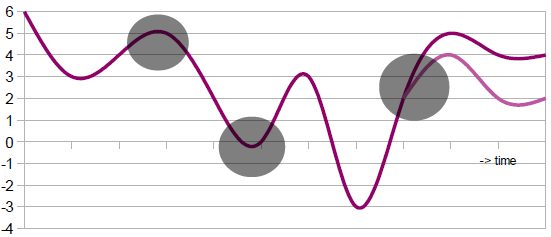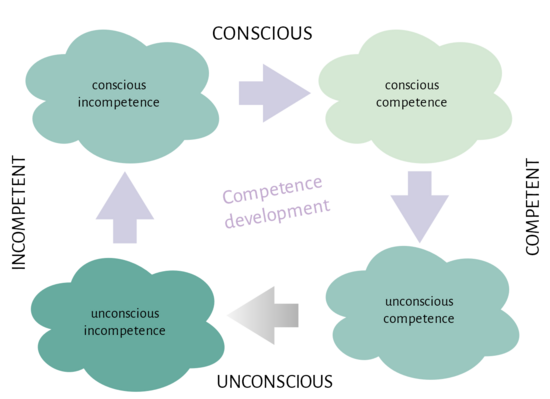A typical learning experience is set out below. The horizontal axis describes time, the vertical axis describes the feeling associated with the project and its outcomes.
From an evaluating perspective, the linear parts might be less interesting. The most valuable sources for reflection are the curve’s turning points and the ambiguous areas (confusions, sources of learning). The confusions represented by the turning points in the curve confront us with uncertainty and ambiguity. Experiential learning strengthens the ability to deal with these challenges by learning from them.
Contents
Circularity
Furthermore, it must be taken into account that the learning process itself consists of different micro-processes that are circular in themselves. Learning is in that sense a spiral– action/gaining experience, reflecting, concluding, moving on (Kolb & Kolb 2005)[1]. Consequently, experiential learning processes include space for experience and regular meta-reflection.
Interplay of different ways of thinking
These micro-processes within the bigger learning process could also be understood as interplay between different states of thinking (i. e. Divergent and Convergent Thinking) or acting (active, passive), or forms (speaking, reading, watching, individual, group learning...). Learning processes can give the different forms and ways of thinking adequate space, i. e. in their Method Mix.
Link to Competence Development
Competences are the formation of different learnings in a set of knowledge, skills and attitudes. Also this more complex process is an iterative and circular learning journey.
Link to Learning to Learn
This model of learning as circular process illustrates, that learners and educators need to view their action regularily from an observative meta-position, in order to define and tackle their challenges. Successful learning from a life-long perspective depends on how learners and facilitators can apply reflection in complex, unique, open-ended situations as part of the competence of learning-to-learn.
References
- ↑ Kolb, Alice Y.; Kolb David (2005): Learning Styles and Learning Spaces: Enhancing Experiential Learning in Higher Education; in: Academy of Management Learning & Education; Vol. 4, No. 2 (Jun., 2005); pp. 193-212
Nils-Eyk Zimmermann
Editor of Competendo. He writes and works on the topics: active citizenship, civil society, digital transformation, non-formal and lifelong learning, capacity building. Coordinator of European projects, in example DIGIT-AL Digital Transformation in Adult Learning for Active Citizenship, DARE network.
Blogs here: Blog: Civil Resilience.
Email: nils.zimmermann@dare-network.eu







